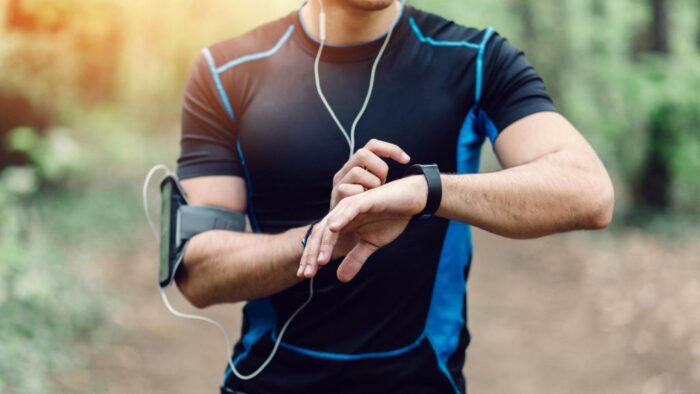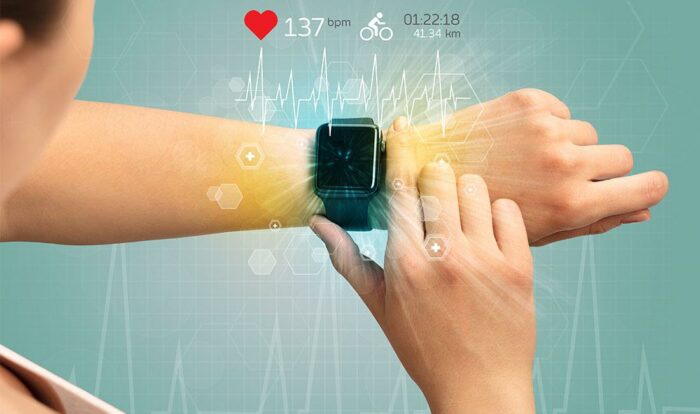Understanding the Importance of Heart Rate Tracking in Fitness Wearables
Heart rate tracking is an absolutely vital aspect of fitness wearables and plays a truly significant role in monitoring and enhancing one’s overall fitness. The capability to accurately measure heart rate empowers users to grasp their exertion levels during workouts, track progress over time, and optimize their training routines for utmost efficiency.
The popularity of wearable devices with optical heart rate sensors, like Fitbit and other well-known fitness trackers, has surged due to their unparalleled convenience and user-friendly nature. These sensors employ photoplethysmography technology to gauge alterations in blood volume beneath the skin, thereby estimating heart rate. However, wrist-worn heart rate monitors may be less precise when compared to chest strap monitors or electrocardiogram (ECG) measurements.
A comparison between the accuracy of wrist-worn heart rate monitors and chest straps reveals that chest straps generally offer more exact readings. This stems from the fact that chest straps directly capture electrical signals emitted by the heart through ECG technology. Nonetheless, recent advancements in algorithm development have significantly bolstered the precision of wrist-worn devices by incorporating supplementary metrics such as motion data derived from accelerometers or gyroscopes.
Recognizing the criticality of accurate heart rate measurement algorithms employed in wearables is paramount for users who seek dependable data on their cardiovascular performance. These algorithms meticulously analyze unprocessed sensor data amassed by wearable devices during diverse activities such as running on a treadmill or cycling outdoors. By perpetually refining these algorithms, manufacturers can heighten the exactitude of heart rate monitoring features within wearables while simultaneously ensuring users are not burdened with inconvenience or discomfort – ultimately providing them with invaluable insights into their health and fitness levels.

Exploring the Different Types of Heart Rate Monitoring Technology
The realm of wearable heart rate monitors has witnessed a surge in popularity over recent years. Prominent devices such as the Apple Watch and Garmin have bestowed upon users the remarkable ability to monitor their heart rates during physical activity. Among the various technologies employed in these devices, optical heart rate sensors reign supreme. These sensors employ light to gauge fluctuations in blood flow, thus furnishing users with precise heart rate readings. Typically nestled on the underside of wrist-worn fitness trackers, these sensors ensure continuous tracking of one’s cardiac rhythm throughout the day.
Another category of wearable technology that bestows upon us the power to monitor our heart rates is chest strap heart monitors. These contraptions consist of a strap snugly encircling our chests, diligently detecting electrical signals emanating from our hearts and wirelessly transmitting them to compatible devices like smartphones or smartwatches. Although perhaps less convenient than their wrist-worn counterparts, chest straps are often hailed for their superior accuracy when it comes to measuring exercise intensity and energy expenditure.
When choosing a wearable device for monitoring your precious heartbeat, accuracy emerges as an imperative consideration. Evidentiary studies reveal that while wrist-worn fitness trackers may furnish reasonably accurate step count data, their proficiency at measuring heart rates exhibits substantial variation across different brands and models. In-depth research comparing sundry devices has unearthed instances where certain wrist-worn wearables—such as those crafted by Xiaomi—tend to inflate calorie burn estimations during aerobic activities vis-à-vis more reliable methodologies like indirect calorimetry.
To conclude this discourse on wearable technologies designed for monitoring one’s pulse, it becomes evident that multiple options exist within this realm. Optical sensors adorning wrist-worn fitness trackers proffer convenience alongside ceaseless tracking throughout each waking hour; nevertheless, they may not unfailingly deliver highly accurate readings during arduous workouts. On the other hand (or chest), chest strap monitors offer greater precision but can be less agreeable or practical for everyday usage. When selecting a wearable device to monitor your activity levels and gauge the intensity of your exercise endeavors, it behooves you to contemplate both accuracy and convenience factors in accordance with your individual needs.

The Role of Optical Heart Rate Sensors in Wearable Devices
The advent of optical heart rate sensors has brought about a paradigm shift in the realm of wearable devices, exemplified by popular products such as the Garmin Vivosmart and other wrist-worn fitness trackers. These sensors serve as indispensable tools for users seeking to gauge their heart rate while engaging in physical activities. By harnessing the power of light to discern fluctuations in blood flow, these ingenious optical sensors are able to capture heart rate data with remarkable precision, eliminating the need for bothersome chest straps.
One striking advantage that sets optical heart rate sensors apart is their ability to provide reasonably accurate measurements even amidst vigorous arm movements. Unlike conventional chest strap monitors that necessitate an uncomfortably snug fit against one’s skin, wrist-worn devices enable continuous monitoring of your cardiac rhythm throughout various exercise regimens without any discomfort or disruption to your workout routine.
Over time, substantial advancements have been made in refining the accuracy of optical heart rate measurement. While it may not rival medical-grade equipment in terms of exactitude, these sensors are well-equipped to furnish users with authentic beats per minute (BPM) readings pertaining to their cardiovascular activity. However, it is imperative to acknowledge that accuracy levels can fluctuate across different brands and models of wearable HR trackers. Variables like skin tone variations, presence of tattoos on the wrist area, and prevailing ambient lighting conditions can exert an influence on the reliability of readings obtained through this pioneering technology reliant on optical sensing.
To summarize succinctly, optical heart rate sensors have instigated a groundbreaking revolution when it comes to tracking our pulse rates via wearable devices; think fitness trackers et al. They proffer individuals a hassle-free and convenient avenue for keeping tabs on crucial health metrics during workouts or day-to-day pursuits sans reliance upon cumbersome chest straps. Although slight discrepancies might manifest among varying models concerning accuracy parameters – all thanks due consideration given towards environmental factors – these cutting-edge sensors consistently deliver commendably precise measurements courtesy of their astute utilization of light-based technology in detecting vital changes in blood flow.
Comparing the Accuracy of Wrist-Worn Heart Rate Monitors and Chest Straps
Heart rate monitoring holds immense significance in tracking health and fitness, unraveling valuable insights into our cardiovascular well-being. The advent of consumer wearable devices like fitness trackers and smartwatches has paved the way for wider accessibility to heart rate monitoring among the masses. Nevertheless, it is essential to note that there exists a divergence in accuracy between wrist-worn heart rate monitors and chest straps.
Numerous studies have delved into scrutinizing the precision of heart rate measurement in both wrist-worn devices and chest straps. In a study conducted on healthy adults encompassing diverse wrist sizes, researchers discovered that optical heart rate monitors worn on wrists seemed inclined to underestimate reported heart rates when juxtaposed with measurements obtained from chest straps. This discrepancy could potentially stem from factors such as motion artifacts or alterations in blood flow during physical exertion.
Another study sought to evaluate sensors’ accuracy based on their efficacy in capturing average heart rates and accurately detecting changes in heart rate trends. The outcomes revealed that while wrist-worn devices were commendable for tallying steps taken and providing an overall estimation of activity levels, they proved less precise than their chest strap counterparts when it came to measuring actual heart rates. Consequently, this research underscored the notion that individuals seeking utmost measurement accuracy during workouts or training sessions may find greater reliability with a chest strap.
When selecting a device catering to one’s health and fitness needs, consumers should bear these disparities firmly within their grasp. While wrist-worn gadgets proffer convenience and user-friendly features, they might not furnish highly meticulous measurements specifically pertaining to trackingheart rates amidst intense physical activities or exercises demanding elevated precision levels. Henceforth, assessing the variance in accuracy between wrist-worn monitors and chest straps can empower individuals to make judicious decisions regarding which type of device aligns most effectively with their distinct requisites.
Evaluating the Effectiveness of Heart Rate Measurement Algorithms in Wearables
The perplexing nature of fitness wearables lies in their ability to track heart rate, illuminating a trove of valuable health information. Through the lens of these devices, individuals can meticulously monitor their heart rate during physical exertion and gauge the intensity of their workouts. This feature proves particularly advantageous for those striving to enhance overall fitness or individuals with cardiac ailments necessitating vigilant observation of cardiovascular well-being.
Within this study, an evaluation unfolded to discern the efficacy of diverse heart rate measurement algorithms employed by wearables. Participants were enlisted for this investigation and instructed to adorn themselves with two distinct devices – a Samsung Galaxy Watch 2 and a Garmin contraption – while engaging in exercise upon a treadmill’s relentless belt. The objective entailed scrutinizing how precisely these gadgets could trace heart rate fluctuations whilst furnishing accurate data pertaining to fitness metrics such as maximum pulse frequency, caloric expenditure, and step count.
Revelations emerged that both devices exhibited commendable acuity when it came to tracking heart rate vis-à-vis chest strap monitors which serve as benchmarks for accuracy. Nonetheless, precision manifested variation contingent upon individual activity levels and types of exercises undertaken. Notably observed was the proclivity for wrist-worn mechanisms to underestimate heart rates amid high-intensity regimens while delivering more reliable readings during low-intensity routines.
Ultimately, this exploration underscores that although wearable marvels facilitate monitoring one’s cardiac rhythm throughout physical endeavors, certain limitations persist regarding accuracy. Ergo users must grasp these constraints assiduously and proceed judiciously when relying solely on wearable technology as means for precise health appraisals.